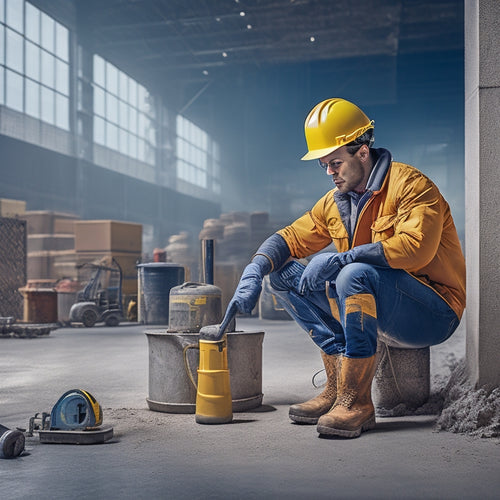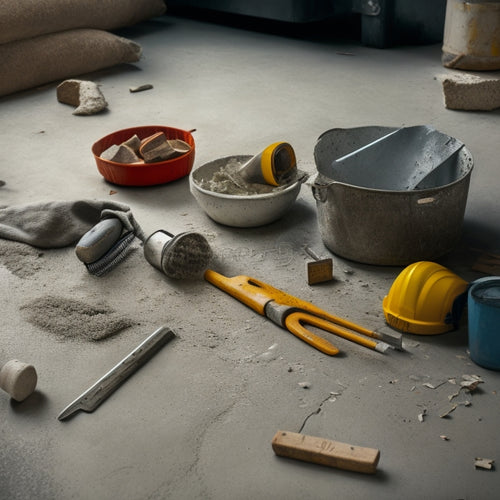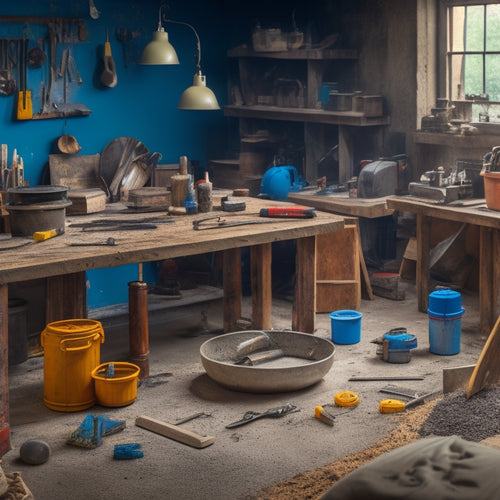
Essential Tools for Concrete Block Exterior Painting
Share
When painting a concrete block exterior, you'll need a range of specialized tools to guarantee a professional-looking finish. Start with power washing equipment, like a high-pressure washer and accessories, to clean the surface. Next, gather scraping and sanding tools, such as putty knives, wire brushes, and sandpaper, to remove old paint and smooth out imperfections. Don't forget masking and taping essentials, primer and paint application tools, roller extension poles, and brush and roller covers. Additionally, have drop cloths and tarps on hand to protect surrounding areas, and invest in safety gear and protection. With these tools, you'll be well-equipped to tackle the project - and that's just the beginning of what you'll need to know.
Key Takeaways
• A high-pressure power washer is necessary for effective cleaning of concrete blocks before painting, with a minimum of 3000 PSI recommended.
• Surface preparation tools like scrapers, sandpaper, and wire brushes are essential for removing old paint and smoothing surface imperfections.
• Masking and taping are critical for achieving crisp lines and sharp edges, with high-adhesion masking tape and low-adhesion painter's tape being essential.
• The right primer and paint application tools, such as natural bristle brushes and microfiber rollers, are crucial for a long-lasting and professional-looking finish.
• Safety gear, including goggles, respirator masks, gloves, and steel-toed boots, is vital for protecting oneself from paint, solvents, and other hazards during the painting process.
Power Washing Equipment Needed
You'll need a high-pressure power washer with a minimum of 3000 PSI and a wide fan tip to effectively remove dirt, grime, and old paint from the concrete blocks before applying a new coat. This powerful equipment will help you tackle tough cleaning jobs with ease.
There are various pressure washer types to choose from, including gas-powered, electric, and diesel-powered models. For concrete block painting, a gas-powered washer is recommended due to its high pressure output.
When selecting a power washer, consider the power washing techniques you'll be using. Will you be using a wide fan tip for general cleaning or a narrow tip for precision cleaning? You may also want to invest in additional nozzles and accessories, such as a soap dispenser or brush attachment, to enhance your cleaning capabilities.
Remember to always follow safety guidelines when operating a power washer, including wearing protective gear and maintaining a safe distance from the spray.
With the right equipment and techniques, you'll be able to efficiently clean your concrete blocks and achieve a smooth, even finish for your new paint job.
Scraping and Sanding Tools Required
When you're preparing concrete blocks for painting, you'll need to remove old paint and smooth out surface imperfections.
You'll accomplish this by scraping off loose paint and sanding down rough spots, ensuring a strong bond between the block and the new paint.
To get started, gather your scraping and sanding tools, which will help you achieve a clean, even surface ready for primer.
Remove Old Paint
Before tackling a fresh coat of paint, scrape off old, flaking paint with a putty knife or a stiff-bristled brush to guarantee a strong bond between the concrete block and new paint. This vital step ensures the new paint adheres properly, preventing peeling and flaking.
Effective paint removal techniques require the right tools for the job. For tough, thick layers of old paint, use a putty knife to scrape off the bulk of it. Then, switch to a stiff-bristled brush to remove any remaining residue. Don't forget to wear protective gear, including gloves and safety goggles, to avoid injury from flying debris.
When it comes to surface preparation tips, remember to work in small sections to maintain control and avoid spreading old paint further. Use a gentle touch to avoid gouging the concrete block, which can create uneven surfaces.
Smooth Surface Imperfections
With old paint removed, use a wire brush or scraper to aggressively attack rough, pitted, or uneven surfaces, knocking down high spots and filling in low areas to create a more uniform base for painting. This vital surface preparation technique is essential for a smooth, even finish. You'll be amazed at the difference it makes in the final result.
To further improve the texture of your concrete block surface, employ these texture improvement methods:
-
Use a putty knife or joint knife to fill in deep holes or cracks, making sure to press the filler firmly into the gap.
-
Switch to a sanding block or orbital sander with a coarse grit sandpaper to remove any remaining imperfections.
-
For particularly rough areas, try using a rotary tool with a wire wheel attachment to aggressively remove texture.
- Finish with a finer grit sandpaper to smooth out the surface, ensuring a strong bond between the concrete and paint.
Prepare for Primer
You're now ready to take your concrete block surface to the next level by using scraping and sanding tools to prepare it for primer. This essential step guarantees a strong bond between the concrete and the primer, resulting in a durable and long-lasting finish.
To prepare your surface, you'll need a putty knife or scraper to remove any loose or flaking concrete, and a wire brush to scrub away dirt and grime.
Next, use a sanding block or orbital sander to smooth out the surface, feathering out any rough edges or bumps. Depending on the primer type you'll be using, you may need to achieve a specific level of surface roughness to guarantee peak adhesion.
Be sure to inspect your surface conditions carefully, as any imperfections will be magnified once the primer is applied.
Masking and Taping Essentials
Your masking and taping strategy will make or break the crisp, clean lines that separate your beautifully painted concrete blocks from the surrounding surfaces. A well-executed masking plan guarantees a professional-looking finish, saving you time and effort in the long run.
When it comes to choosing the right tools, you'll need a combination of masking tape and painter's tape specifically designed for concrete block painting.
Here are the essentials to get it right:
-
Masking tape: A high-adhesion tape that can withstand the rough texture of concrete blocks. Look for tapes with a high tensile strength to prevent stretching or tearing.
-
Painter's tape: A low-adhesion tape for creating sharp, clean edges on trim, windows, and doors. This tape is easier to remove without leaving residue.
-
Tape applicator: A tool that helps you apply tape quickly and smoothly, guaranteeing straight lines and preventing wrinkles.
- Tape remover: A solvent-based or adhesive-free remover for easy tape removal without damaging the paint or surface.
Primer and Paint Application Tools
Selecting the right primer and paint application tools is essential for achieving a uniform, long-lasting finish on your concrete blocks.
You'll need to choose a primer that's compatible with your concrete blocks and the type of paint you're using. There are different primer types, such as epoxy, acrylic, and silane, each with its own advantages and disadvantages. For example, epoxy primers provide excellent adhesion and durability, while acrylic primers are more versatile and suitable for most paint finishes.
When it comes to paint application tools, you'll need to decide on the right brush or roller for the job. Natural bristle brushes are ideal for oil-based paints, while synthetic brushes work better with water-based paints. Rollers, on the other hand, are great for large surfaces and can produce a smooth, even finish.
You'll also need to take into account the nap length and material of the roller, as these factors can affect the final result. By selecting the right primer and paint application tools, you'll be able to achieve a professional-looking finish that will last for years to come.
Roller Extension Poles Necessary
Two essential accessories for painting concrete blocks are roller extension poles, which allow you to reach high areas and cover large surfaces efficiently. With these poles, you can adjust the roller height to suit your needs, ensuring a smooth and even application. This is particularly important when working with concrete blocks, which can be quite tall and require extensive coverage.
When selecting an extension pole, consider the following factors:
-
Fixed-length poles: Ideal for smaller areas and provide more control over the roller.
-
Telescoping poles: Offer adjustable lengths, making them suitable for larger surfaces and uneven terrain.
-
Fiberglass poles: Lightweight and durable, perfect for heavy-duty use.
- Multi-section poles: Break down into shorter sections for easy storage and transport.
Brush and Roller Covers Required
To guarantee a smooth, even application and prevent damage to your concrete blocks, you'll need high-quality brush and roller covers specifically designed for painting rough, porous surfaces.
For brush types, choose ones with natural or synthetic bristles that can withstand the rough texture of concrete blocks. Angled-cut brushes are ideal for cutting in around corners and edges, while flat brushes are better suited for large, flat surfaces.
When it comes to roller materials, you'll want to opt for microfiber or lambswool covers. These materials are designed to pick up and release a high volume of paint, ensuring an even coat on your concrete blocks.
Microfiber rollers are particularly effective at producing a smooth finish, while lambswool rollers are better suited for textured surfaces.
Make sure to choose the right nap length for your roller cover, as this will affect the finish of your paint job. A shorter nap length is best for smooth surfaces, while a longer nap length is better for textured surfaces.
With the right brush and roller covers, you'll be well on your way to a professional-looking finish.
Drop Cloths and Tarps Needed
When you're about to start painting concrete blocks, you'll need to take measures to protect the surrounding areas from paint spills and stains.
You'll want to lay down drop cloths and tarps to prevent accidents from happening, and to make cleanup easier in case they do.
Protecting Surrounding Areas
You'll need to shield adjacent surfaces from paint spills and stains by laying down drop cloths and tarps around the concrete block area. This vital step in surface protection guarantees that your surrounding landscaping and other sensitive areas remain unblemished.
Without proper protection, paint can seep into crevices and ruin surrounding surfaces, leading to costly repairs.
To guarantee thorough protection, consider the following:
-
Lay down drop cloths around plants and gardens: These delicate areas require extra care to prevent paint stains and damage.
-
Cover nearby walkways and driveways: Paint spills on these high-traffic areas can be hazardous and difficult to clean.
-
Protect windows and doors with tarps: Prevent paint from getting stuck in crevices or seeping into openings.
- Secure tarps with weights or tape: Make sure that your protective coverings stay in place, even in windy conditions.
Preventing Paint Spills
By laying down drop cloths and tarps, you've taken a significant step in protecting surrounding areas, but now it's time to focus on preventing paint spills directly on the concrete block surface.
Spill prevention is essential to maintaining a professional-looking finish and avoiding costly cleanups. To contain paint spills, you'll need to set up a paint containment system around your work area.
This can be achieved by placing a paint tray or bucket on a sturdy, spill-resistant surface, such as a paint tray liner or a spill-proof paint bucket. Additionally, consider using a paint grid or screen to catch any stray paint droplets.
By taking these measures, you'll be able to focus on painting without worrying about making a mess. Remember, paint containment is key to a successful and stress-free painting experience.
Safety Gear and Protection
Your first line of defense against the physical demands and chemical hazards of concrete block painting is a well-stocked arsenal of safety gear and protection.
You're not just painting a pretty face - you're dealing with harsh chemicals, heavy equipment, and physical labor that can take a toll on your body. Don't compromise your health and well-being; invest in the right gear to get the job done safely.
Here are the essentials you shouldn't skip:
-
Safety goggles: Protect your eyes from paint splatters, debris, and chemical splashes. Look for goggles with anti-fog coating and good ventilation.
-
Respirator masks: Breathe easy with a mask that filters out paint fumes, dust, and other airborne contaminants. Choose a mask that fits comfortably and has replaceable filters.
-
Gloves: Heavy-duty gloves will protect your hands from paint, solvents, and abrasion. Opt for gloves with grip patterns to prevent slipping.
- Steel-toed boots: You'll be on your feet for hours, so make sure you're wearing boots that can withstand heavy loads and potential drops.
Cleaning and Touch-up Tools
Concrete block painting requires meticulous attention to detail, and having the right cleaning and touch-up tools on hand secures a professional-looking finish and saves you time in the long run.
You'll need a variety of cleaning supplies to guarantee a smooth, even surface for painting. A stiff-bristled brush or wire scrubber will help remove dirt, grime, and old paint residue from the concrete block. A degreaser or TSP (trisodium phosphate) can be used to dissolve and remove grease, oil, or other stubborn substances.
For touch-up techniques, you'll need precision brushes or small rollers to reach tight spaces and corners. A small, handheld vacuum or dusting brush can help remove debris and dust from crevices and cracks.
Don't forget to have rags and a cleaning solution on hand to wipe down surfaces and clean up spills. With the right cleaning and touch-up tools, you'll be able to tackle even the most challenging concrete block painting projects with confidence.
Frequently Asked Questions
Can I Use Regular Household Cleaners for Power Washing?
Don't even think about using regular household cleaners for power washing!
They're not designed for high-pressure washing and can damage surfaces or leave residue.
Instead, opt for specialized cleaning solutions specifically formulated for pressure washing.
These solutions are engineered to effectively remove dirt and grime without damaging your concrete block exterior.
Do I Need to Prime All Concrete Blocks Before Painting?
Don't let your concrete blocks remain a dull, lackluster backdrop - give them the VIP treatment they deserve!
When it comes to painting, you're probably wondering if priming every single block is necessary. The short answer is, it's highly recommended.
Priming benefits include enhanced paint adhesion, which means a smoother, more even finish that'll make your exterior shine.
How Long Does It Take for Exterior Paint to Fully Cure?
You're wondering how long it takes for exterior paint to fully cure. The answer depends on several factors, including temperature, humidity, and paint type.
On average, it can take anywhere from 7 to 30 days for exterior paint to reach its maximum cure time. During this period, the paint will continue to harden, increasing its durability.
You'll know it's fully cured when it's resistant to scratches and fading. Be patient, and your paint job will last for years to come.
Can I Paint Concrete Blocks in Direct Sunlight?
When you're painting concrete blocks, you're probably wondering if direct sunlight is a good idea. The answer is no.
Direct sunlight can cause the paint to dry too quickly, compromising paint adhesion and leading to premature failure. Additionally, sunlight effects like UV rays can break down the paint's molecular structure, reducing its durability.
Instead, opt for a shaded or cloudy day to guarantee a strong, long-lasting finish.
Is It Necessary to Seal the Paint After It Dries?
When you're done painting, you're probably wondering if sealing the paint is necessary. The answer is yes, it's essential for paint longevity.
Sealing benefits include protecting the paint from UV rays, water, and mildew, ensuring it lasts longer.
You've invested time and effort into painting; don't let it fade or chip prematurely.
Seal it to maintain its vibrancy and durability. You'll be glad you did.
Conclusion
As you stand back to admire your freshly painted concrete block exterior, remember that a job well done is the sum of its parts.
Each tool played an essential role in the transformation, like instruments in a symphony.
With the right equipment and a bit of elbow grease, you've turned a dull, lackluster facade into a vibrant, eye-catching masterpiece that's sure to turn heads.
Related Posts
-

10 Best Tools for Sealed Concrete Flooring on Budget
When starting on a sealed concrete flooring project on a budget, you'll need to prioritize essential tools without sa...
-

Top 10 Concrete Repair Tools for Small Fixes
You'll need the right tools to tackle small concrete repairs efficiently and effectively. When it comes to small fixe...
-

Budget-Friendly Tools for DIY Decorative Concrete Profiling
You can achieve professional-grade decorative concrete results on a budget by investing in the right combination of e...


